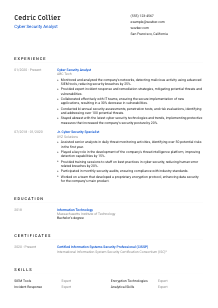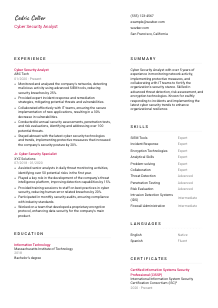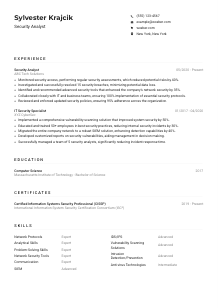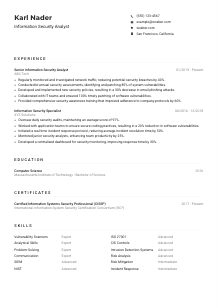Cyber Security Analyst Resume Example
Guarding digital realms, but your resume seems vulnerable? Dive into this Cyber Security Analyst resume example, encrypted with Wozber free resume builder. Uncover how to tailor your cyber security acumen to align with job requirements, fortifying your career's defense as staunchly as the networks you protect!
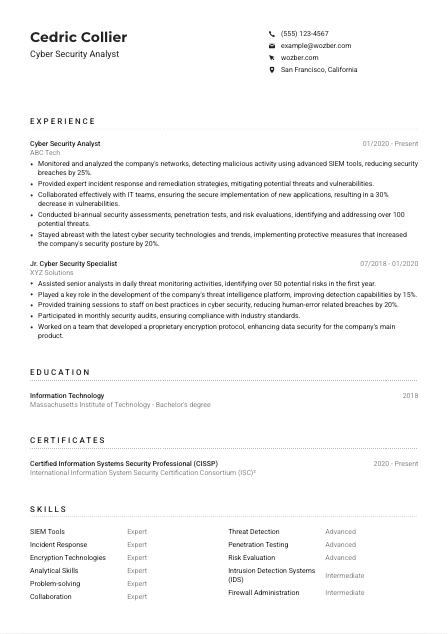
How to write a Cyber Security Analyst resume?
As a Cyber Security Analyst, you understand the importance of safeguarding information. Similarly, crafting a resume that effectively protects and promotes your career goals is paramount. You're about to learn how to construct an ATS-compliant resume tailored specifically for a Cyber Security Analyst position.
With Wozber's free resume builder, optimizing your resume for Applicant Tracking Systems (ATS) and aligning it with the job description becomes a smooth, streamlined process. Let's dive in and build a resume that not only passes through ATS filters with ease but also captivates the hiring manager's attention.
Personal Details
Kicking off your resume with the right personal details sets the tone for a professional and compelling read. Here's how to ensure this section works in your favor, highlighting your suitability for the Cyber Security Analyst role right off the bat.
1. Showcase Your Identity
Starting with your name in a clear, bold font distinguishes you. It's your personal brand logo. Place it prominently at the top, ensuring it's the first detail that catches the eye.
2. Job Title Precision
Below your name, align your present standing or career aspiration with the role you're applying for by stating "Cyber Security Analyst". This immediately informs the employer of your professional domain and ambitions.
3. Crucial Contact Infos
Provide a phone number and a professional email address (think firstname.lastname@domain.com). This basic yet essential information facilitates smooth communication channels with prospective employers.
4. Location Matters
"Must be located in San Francisco, California." By confirming your location as San Francisco, you immediately check a box in the employer's list of prerequisites, streamlining the hiring process.
5. Online Professional Profiles
Adding a URL to a LinkedIn profile can hugely augment your resume, offering a more holistic view of your professional experiences and competencies.
Takeaway
Your personal details are not mere formalities but stepping stones leading hiring managers into your professional world. Craft this section with care, ensuring it reflects not just who you are but also how seamlessly you fit into the Cyber Security Analyst role you're eyeing.





Experience
The Experience section is the core of your resume, elucidating your journey in the cyber security domain. Here's how to mold it to reflect not just your history, but your future potential.
- Monitored and analyzed the company's networks, detecting malicious activity using advanced SIEM tools, reducing security breaches by 25%.
- Provided expert incident response and remediation strategies, mitigating potential threats and vulnerabilities.
- Collaborated effectively with IT teams, ensuring the secure implementation of new applications, resulting in a 30% decrease in vulnerabilities.
- Conducted bi‑annual security assessments, penetration tests, and risk evaluations, identifying and addressing over 100 potential threats.
- Stayed abreast with the latest cyber security technologies and trends, implementing protective measures that increased the company's security posture by 20%.
- Assisted senior analysts in daily threat monitoring activities, identifying over 50 potential risks in the first year.
- Played a key role in the development of the company's threat intelligence platform, improving detection capabilities by 15%.
- Provided training sessions to staff on best practices in cyber security, reducing human‑error related breaches by 20%.
- Participated in monthly security audits, ensuring compliance with industry standards.
- Worked on a team that developed a proprietary encryption protocol, enhancing data security for the company's main product.
1. Dissect Job Requirements
Identify key phrases from the job description, like "monitor and analyze organization's networks" or "collaborate with IT teams", and align your past roles and accomplishments with these tasks.
2. Chronological Precision
List your experiences in reverse chronological order. Start with your current or most recent position, ensuring each entry clearly states your job title, employer's name, and the dates of your tenure.
3. Quantify Your Impact
"Reducing security breaches by 25%" or "identifying over 100 potential threats" are quantifiable achievements that resonate well. Numbers draw attention and provide a tangible measure of your contributions.
4. Relevance is Key
Tailor every point to tie back to cyber security analytics. Even if a role was only tangentially related, find and highlight the aspects that demonstrate relevant skills or knowledge.
5. Highlight Collaboration
Given the job's requirement to "collaborate with IT teams," exemplify instances of teamwork and cross-departmental coordination in your roles to underscore your collaborative prowess.
Takeaway
A well-crafted Experience section proves you're not just suitable for the role but already thriving in similar capacities. Use this section to build a convincing narrative of your career journey, emphasizing achievements and skills pertinent to a Cyber Security Analyst.
Education
Education forms the foundation of your career. For a Cyber Security Analyst, showcasing your educational background is crucial. Let's elevate this section to complement your expertise.
1. Highlight Required Degree
"Bachelor's degree in Information Technology, Computer Science, or a related field" should be prominently listed, mirroring the exact phrasing from the job description when possible.
2. Clear Structure
Organize your educational credentials in a lucid format: Degree, field of study, university or college name, followed by graduation date, ensuring easy readability.
3. Degree Alignment
If your degree directly aligns with the job requirements — like a Bachelor's degree in Information Technology — make sure this is clearly highlighted to catch the recruiter's eye instantly.
4. Relevant Courses and Achievements
Listing relevant courses, certifications, or projects can add depth, especially for recent graduates or those with limited work experience in cyber security.
5. Continuous Learning
Consider mentioning any ongoing or additional educational endeavors, signaling your commitment to staying abreast with the latest in cyber security trends and technologies.
Takeaway
In the realm of cyber security, your education is both your armor and your weapon. Fine-tune this section to reflect not just your qualifications, but also your dedication to continuous learning and growth in this ever-evolving field.
Certificates
Certificates are badges of honor in the cyber security community, showcasing your specialized knowledge and skills. Highlighting them prominently can significantly bolster your resume.
1. Identify Key Certificates
The job description mentions "CISSP or CISM certification is a plus." If you have these, they deserve a prime spot in your resume. They directly align with the employer's preferences.
2. Prioritize Relevance
List certifications that are most relevant to the Cyber Security Analyst role first, even if they might not be your most recent achievements. Relevance trumps chronology here.
3. Validity and Updates
For certifications like CISSP and CISM, ensure you include the dates to show the current validity. Keeping these up-to-date signals ongoing engagement with your professional development.
4. Continuous Certification
The cyber security field evolves constantly. Show your commitment to staying updated by pursuing new certifications and highlighting plans to earn more relevant credentials.
Takeaway
Your certifications map out the landscape of your specialized knowledge in cyber security. Arrange them strategically on your resume to illustrate your depth of expertise and your commitment to professional growth.
Skills
The Skills section is your professional toolkit. For a Cyber Security Analyst, it's essential to align this toolkit with the demands of the job market. Let's optimize it for impact and ATS compatibility.
1. Match Job Description
Starting with skills mentioned in the job posting, such as "SIEM Tools" or "Incident Response," ensures you're speaking the hiring manager's language. This is your first step towards ATS optimization.
2. Balance Hard and Soft Skills
While technical proficiencies are crucial, don't overlook soft skills. Abilities like "Excellent analytical and problem-solving skills" are equally pivotal in embodying the full scope of a Cyber Security Analyst.
3. Skills Organization
Prioritize your skills based on their relevance to the job description. A hierarchy that starts with your strongest, most pertinent skills invites the hiring manager to see your fitment at a glance.
Takeaway
Crafting a Skills section that mirrors the job description not only maximizes your ATS score but also delineates your expertise lucidly. Let this section serve as a testament to your qualifications and readiness for the role.
Languages
In the diverse and interconnected world of cyber security, multilingualism can be a significant plus. Here's how to professionalize and leverage your linguistic skills.
1. Mandatory Language Requirement
"English speaking skills are mandatory." This specific requirement should dictate the prioritization of your language skills, with English listed first, accompanied by your proficiency level.
2. Additional Languages
While English is your primary language of communication, listing additional languages can showcase your ability to work in diverse, multicultural environments.
3. Proficiency Levels
Being clear and honest about your proficiency level in each language optimizes expectations and communication with future employers.
4. Cultural and Regional Knowledge
Beyond mere communication, languages signify an understanding of different cultures and regions, an invaluable asset in global cyber security operations.
5. Language as a Soft Skill
View and present your language skills not just as communication tools but as a reflection of adaptability and learning ability, key soft skills for any Cyber Security Analyst.
Takeaway
Leveraging your languages in the cyber security arena enhances your appeal to global organizations. It's not just about speaking languages; it's about speaking to diverse audiences and understanding global threats.
Summary
Your Summary is the handshake that greets the hiring manager, setting the stage for your resume. Here's how to craft one that resonates with both ATS and human readers, capturing the essence of why you're the perfect Cyber Security Analyst for the job.
1. Reflect on Job Essence
Begin by absorbing the core requirements of the Cyber Security Analyst role, emphasizing your alignment with phrases like "experienced in monitoring network activity and implementing protective measures".
2. Strong Introduction
Introduce yourself with confidence, stating your professional identity and core expertise upfront. This isn't just history; it's your brand promise.
3. Skill and Achievement Highlight
Mention key skills and accomplishments early on. Phrases like "skilled in advanced threat detection" or "implemented security measures increasing the company's security posture by 20%" directly link your capabilities with job requirements.
4. Brevity and Clarity
While your summary must be compelling, keeping it concise ensures that every word holds power and purpose, inviting the reader to delve deeper into your resume.
Takeaway
A well-crafted summary doesn't just introduce you; it advocates for you, highlighting your qualifications in a manner that's impossible to overlook. Use it to signify not just your readiness but your enthusiasm for the Cyber Security Analyst role.
Launching Your Cyber Security Analyst Journey
With the insights and strategies you've now acquired, crafting a resume that stands out in the cyber security job market is within your grasp. Remember, each section of your resume is a chapter in your professional story. Use Wozber's free resume builder with its ATS-friendly resume template and ATS resume scanner to ensure your narrative is not just seen but truly appreciated by hiring managers.
Your meticulously tailored, ATS-optimized resume is your passport to the next milestone in your Cyber Security Analyst career. Start building it today, and open the door to new, thrilling opportunities.

- Bachelor's degree in Information Technology, Computer Science, or a related field.
- Minimum of 3 years of experience in cyber security, preferably in threat analysis or incident response.
- Strong understanding of security protocols, threat detection tools, and encryption technologies.
- Certified Information Systems Security Professional (CISSP) or Certified Information Security Manager (CISM) certification is a plus.
- Excellent analytical and problem-solving skills with a keen eye for details.
- English speaking skills are mandatory.
- Must be located in San Francisco, California.
- Monitor and analyze organization's networks for malicious activity using Security Information and Event Management (SIEM) tools.
- Provide incident response and remediation recommendations when security breaches or vulnerabilities are discovered.
- Collaborate with IT teams to ensure the secure design and implementation of applications and systems.
- Conduct regular security assessments, penetration testing, and risk evaluations to identify potential threats.
- Stay updated with the latest cyber security trends, technologies, and threat intelligence to ensure the organization's protective measures are current.





